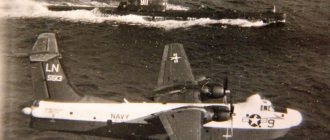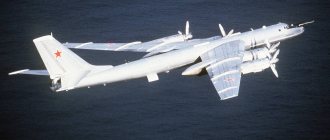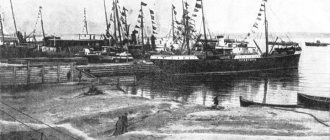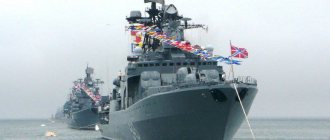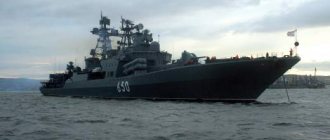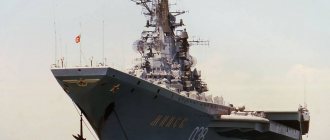Project 183 boats
Boats of project 183 – 622 units.
Project 183: TK-383 TK-1244 – TK-1294 TK-1298 – TK-1316 TK-1395 TK -503 TK-778 TK-779 TK-1115 TK-1149 TK -1362 TK-1450 TK-1401 – TK- 1433 TK-1335 TK-97
Project 183T: TK-? 04/12/1951 / 09/26/1951 / 11/20/1953
Project 183TK: TK-39 – TK-51
Project 183U: TK-38 09/07/1956 / 05/29/1957 / 12/31/1957
Project 183C: KTs-3 KTs-5 – KTs-9 KTs-23 KTs-28 KTs-29 KTs-31 KTs-37 – KTs-39 KTs-44 KTs-45 KTs-47 – KTs-62 KTs-65 KTs- 66 KTs-70 KTs-73 – KTs-103 KTs-108 KTs-109
Displacement: normal: 61.5 tons. total: 66.5 tons. Dimensions: length: 25 meters. width: 6.1 meters. draft: 1.2 meters. Speed: maximum: 43 knots. economic: 14 knots. Cruising range: full speed: 600 miles at 33 knots (cruising speed). economical speed: 1000 miles at 14 knots. Engine type: 4 diesel engines M-50F or M-50F-1 or M-50FTK - total power 4,800 hp. Autonomy: 5 days. Armor: The wheelhouse and anti-aircraft guns were armored with 7 mm armor. Armament: 2x2 – 25 mm anti-aircraft guns “2M-3” (4000 rounds). 2 single-tube torpedo tubes 533 mm “TTKA-53M”. 8 depth charges “BB-1”. 6 – 8 sea mines in overload “KB-3” or “AMD-500”. Crew: 2 officers and 12 sailors.
Modifications of boats created on the basis of Project 183: Project 183 – serial torpedo boat. Project 183A - one production boat was sheathed in arctilite (bakelized plywood with pressed piano wire between the veneer). Project 183T - experimental TKA with an additional gas turbine engine. Project 183TK - serial TKA with an additional gas turbine engine. In total in 1955-57. built 25 boats. Project 183U - an experienced TKA with 4 torpedo tubes and a new power plant and 3 anti-aircraft installations. The unsuccessful project did not go into series. Project 183TU - project of a boat with 4 torpedo tubes. Project 183T.2 - improved TKA of Project 183TU, with a new power plant and 3 anti-aircraft installations. Project 183Ts – radio-controlled target boat. A total of 60 boats were built. Project 183SH - headquarters version. Project 183E - experimental boat for testing missile weapons. Project 183R - the first serial domestic RKA (information HERE). Project 183Ya.2 – project of a boat with M.503 diesel engines. Project 199 - in 1953, a project was developed for a small submarine hunter, which was also intended for naval units of the border troops. A total of 52 of these boats were built.
The main type of Soviet torpedo boat, created in the late forties of the last century, for many years became the large Project 183 TKA with a wooden hull. In accordance with the technical design, these boats were “large, ridgeless, semi-planing, with sharp-chine hull lines.” To facilitate passage through inland waterways, the boat's mast was designed to fall, which significantly reduced its overall height. Despite a number of comments that emerged during state tests, Project 183 torpedo boats with some modifications were built in a large series from 1952 to 1960. In general, according to the sailors, the boats turned out to be successful and therefore became “basic” not only in the creation of a number of their modifications, but also in the development of the project for the world’s first missile boat (Project 183-R). The lead boat, Project 183, was delivered to the Navy in 1949. Construction was carried out from 1949 to 1960 at factories: No. 5 in Leningrad, No. 460 in Sosnovka and No. 602 in Vladivostok. A total of 674 boats were built in the USSR (with all modifications). Another 80 similar boats were built in China under Soviet license. In addition, since 1964, 40 local crew boats have been built in the boat’s hull. In the 60s, some of the boats from the USSR Navy were transferred to the fleets of the Warsaw Pact countries, Asia and Africa. A total of 138 boats were transferred: 31 to the GDR, 24 to Egypt, 20 to Poland, 12 to Iraq, 12 to China, 11 to Cuba, 10 to the DPRK, 8 to Indonesia, 4 to Guinea, 4 to Somalia, 2 to South Yemen.
Project 183RThe development of the boat for the P-15 missile was entrusted to the Leningrad TsKB-5. It was located at the Leningrad plant, founded in 1933 as a shipyard of the OGPU Marine Border Guard, and in 1939 transformed into Plant No. 5 of the NKVD. During the war, the Navy became the main customer, and the plant was transferred to the People's Commissariat of Shipbuilding. For the first time in the post-war years, OKB-5, the so-called “sharashka”, was organized on the territory of the plant, which employed mainly a “special contingent” - a group of prisoner engineers led by Pavel Gustavich Goykins, transferred from a similar organization in Kazan - OKB-340. They developed the largest of the post-war torpedo boats, Project 183, which was put into service in 1949. The boat, Project 183, was created using the experience of building Soviet and foreign torpedo boats (Elko, Higgins, Vosper), arrived under Lend-Lease and were going to the USSR.
Paradoxically, our sailors “sailed into the rocket age on a wooden boat.” This was not at all explained by the peculiarities of the national industry. The first English torpedo boats were also made of wood, the wreckage of which is presented as a trophy in the Central Naval Museum. The choice of material, so strange for “initiated navigators,” was explained by the fact that, with equal strength, the steel hull plating turned out to be too thin and quickly rusted. The same problems, albeit to a lesser extent, arose with aluminum alloys. In addition, there was little “winged metal” in our country: in the pre-war years there was not enough of it even for the most critical aircraft parts. Later, another advantage of the wooden hull of the boat was reflected - it reflected only 4% of the radar radiation incident on it.
The boat pr. 183 turned out to be very successful. Subsequently, more than 360 such ships with diesel engines were built in our country, as well as 25 boats of Project 183T with an additional accelerator gas turbine unit and 52 boats in the anti-submarine modification of Project 199. The boat of Project 183 served as the basis for the creation of a missile modification, developed under the leadership of chief designer Evgeny Ivanovich Yukhnin.
By removing the 533-mm torpedo tubes and the aft twin 23-mm anti-aircraft installation 2M-ZM, two open launchers with rail-type guides for missiles were installed on the Project 183R boat. Each guide included two supporting surfaces located at an angle of 11.5° to the horizontal, connected by a U-shaped profile. Initially, the length of the guides was 4.5 m, but based on the results of testing it was possible to reduce it to 2.85 m.
It should be noted that the strict weight and size restrictions on launchers in this case yielded a positive result: the designers did not follow the dead-end path of creating rotary, much less stabilized, launchers. True, certain restrictions were imposed on the tactics of using missile weapons: for several minutes of pre-launch preparation, the boat had to maintain a course close to the direction of the preemptive meeting point between the missile and the target.
The first design work on the “boat with jet weapons” began back in 1952. A couple of years later, its technical design was released. From October 1956 to August 1957, at the Rzhevka training ground near Leningrad, more than 10 throw launches of mock-ups of the P-15 sustainer stages equipped with a full-scale starting engine were carried out from a stand simulating the wheelhouse and fragments of the deck of a missile boat. Based on the results of launches of large-scale rocket mock-ups with full-scale launch accelerators, it was determined that it was necessary to introduce gas deflectors for the launch engine jet and to protect the deck flooring in front of the launchers with sheets of aluminum-magnesium alloy. Since the wooden cabin became unusable after several starts, further work (both design and testing) was carried out in relation to the version with a steel cabin.
An examination of the experimental animals placed on the stand allowed us to draw a conclusion about the acceptable level of noise exposure in the premises of combat posts during a rocket launch.
From October 28, 1957 to March 13, 1958, autonomous tests of missiles took place from a rocking stand simulating pitching, installed at the Crimean test site Peschanaya Balka. The first launch was unsuccessful due to an autopilot failure, the other three were successful.
In addition, at the purely land Kapustin Yar test site on June 16, 1958, a rocket with an autonomous control system was launched from a non-standard launcher until the main engine fuel was completely exhausted, at the entrance of which a range of about 62 km was achieved.
The delivery of Project 183R missile boats to Cuba during the Cuban missile crisis was carried out by Soviet cargo ships in characteristic container boxes placed on the deck.
Missile boat pr. 183R.
From the coastal installation of the Crimean test site, since July 24, 1958, three missiles equipped with homing heads were mainly successfully launched, while during the last test on August 16, they hit the target for the first time.
In 1957, two boats were re-equipped at Leningrad Plant No. 5 - TKA-14 and TKA-15, which moved to the Black Sea via inland waterways. The main external difference between the TKA-14 Project 183E and subsequent production boats Project 183R was the open placement of missiles on guides without metal hangar-like covers. The second boat was equipped only with the ship’s missile system equipment, which served to carry out remote launch of missiles from the first boat using cable communication between the boats. Looking ahead, we note that after the completion of testing of the P-15 in 1960, TKA-14 was assigned to the 41st brigade of torpedo (later missile) boats of the Black Sea Fleet, and TKA-15 remained in Feodosia. Later TKA-14 was renamed R-14, and in 1967 it was written off and dismantled.
It was assumed that the first launch on October 16, 1957 would be carried out in unmanned mode. The “crew” of experimental sheep remained on TKA-14, and pre-launch commands were supposed to come from TKA-15 along cable routes. On the left launcher of the TKA-14 boat a size-and-weight model with a full-scale launcher was placed, on the right - a rocket in full telemetry configuration. However, the weather became fresher, and the resulting disturbances caused the cables to break. But they decided not to postpone the first launch. On the shooting boat there were five TsKB-5 employees, including chief designer E.I. Yukhnin, who personally carried out all the launch operations. The people remained unharmed, although the animals in the cockpit at the bow of the boat suffered ear injuries.
Having made sure that the launch was safe for the crew, they set the boat in motion and launched the fully equipped rocket. Unfortunately, due to the failure of the radar homing head, the missile fell into the sea, flying 38 km. But four days later, for the first time in the world, a missile launched from a boat hit the target with a direct hit.
Joint tests began on September 24 and were carried out by launching missiles equipped with radar homing heads from a boat. At the first stages, the testers were plagued by failures, in some cases not even related to missile defects. So, a couple of times the rockets went into flight “of their own accord”: either due to a malfunction in the ship’s equipment, or due to erroneous actions of the operators. Of the 13 launches carried out on April 22, 1959, only one achieved a direct fall. In four launches, the missiles fell near the target or flew over it, which allowed them to be considered partially successful.
Fires that broke out in the tail section of the rocket also caused a lot of trouble. The liquid-propellant rocket engine simply failed four times. The cause of the fires turned out to be the drawing of a hot stream of exhaust from the turbopump unit into the compartment under the influence of the so-called bottom vacuum formed in flight at the tail end of the rocket. The poor design of the exhaust pipe had its effect. There were no fires during ground bench testing, since there was no bottom vacuum. The homing head also did not work reliably.
Failures in testing provoked the anger of the authorities. AND I. Bereznyak thus received a severe reprimand, which was lifted only shortly before the completion of the tests.
The management of the test site decided to interrupt the tests until September 30 to eliminate deficiencies.
However, the next launch took place on July 16: the designers tried to bring the systems and components of the rocket to an operational state as quickly as possible. In particular, the exhaust pipe of the turbopump unit was lengthened, bringing its section further away from the tail of the rocket. The improvements turned out to be quite effective: almost all eight launches carried out before August 28 were successful, and joint tests of a missile with a radar homing head were successfully completed. During the final salvo of the State Test program, the target ship TsL-61 was sent to the bottom - the former destroyer Animisimo, which was inherited by the USSR during the division of the fleet of defeated fascist Italy and for several years was part of the warships of the Black Sea Fleet under the name "Ladny".
Exactly two months later, the final launch of tests of missiles with a thermal homing head, which began on August 29, 1959, took place. To give the targets the proper contrast in the infrared range, they were equipped with gas burners or braziers with burning oil placed on low truss masts.
Missile boats pr. 205.
Ten launches tested a modification of the P-15T missile, equipped with the USSR’s first round-the-clock thermal (infrared) homing head “Condor”, developed at NII-10 by a team led by Dmitry Pavlovich Pavlov. Work on this version of the rocket began only on May 13, 1957, by order of the Council of Ministers. Despite the fact that only half of the launches were completed successfully, the results were considered satisfactory. The joint use of missiles with radar and thermal homing heads was intended to increase the effectiveness of missile weapons in the face of organized enemy counteraction.
Along with the shortcomings, the tests also showed prospects for improving the complex. In particular, instead of the initially specified launch range of 25 km, it was possible to achieve a value of 35 km. The P-15 missile was guaranteed to fly at a distance of 40 km, but in many tactical situations, effective use at this range was not provided by target designation means.
The adoption of the complex consisting of P-15 missiles with radar and thermal seekers, the Rangout target detection and tracking station, and the Klen equipment was formalized by a decree of March 8, 1960. The range range was set from 8 to 35 km, flight speed - 1100-1200 km/h, flight altitude - 100-200 m. The weight of the warhead was 500 kg. The hit probability was estimated at 0.7. But even before the complex was put into service, serial production of missiles began at plant No. 116 in the Far Eastern city of Arsenyev, previously busy with the production of Yak-18 aircraft.
In accordance with the decree of December 3, 1958, the construction of boats was carried out at factories No. 5 (in Leningrad) and Ng602 (Vladivostok Shipyard). The boats of Project 183R were intended for serial construction, differing from the experimental ones in a slightly different mast with a “Rangout” station, the use of lightweight metal shelters for missiles open at the ends, and the construction of the deckhouse made of steel instead of wood.
Missile boats of Project 183R, compared to their torpedo counterparts of Project 183, with the same length of 25.5 m and a width of 6.2 m, had a total displacement increased from 66.4 tons to 81 tons. The speed decreased from 43-44 to 38 knots, but the range increased from 700 to 1000 miles. The crew increased from 14 to 17 people.
However, the boats of Project 183R became a kind of by-product of the creation of the experimental Project 183E. Initially, the P-15 was intended for a larger boat. Its placement on boats based on Project 183 was not provided for in the shipbuilding plans for the VI Five-Year Plan of 1956-1960. Only a year after the start of work on the P-15, the decree of July 17, 1956 determined the use of these missiles on Project 183R. Until 1960, it was planned to build 48 boats, Project 183R.
A total of 112 boats entered service, including 54 converted from previously produced torpedo boats of Project 183. In particular, 26 missile boats were assembled at Plant No. 5 and another 30 were converted from Project 183 boats.
Table of contents
Literature
Boats of project 183 – 622 units.
Displacement: normal: 61.5 tons. total: 66.5 tons. Dimensions: length: 25 meters. width: 6.1 meters. draft: 1.2 meters. Speed: maximum: 43 knots. economic: 14 knots. Cruising range: full speed: 600 miles at 33 knots (cruising speed). economical speed: 1000 miles at 14 knots. Engine type: 4 diesel engines M-50F or M-50F-1 or M-50FTK - total power 4,800 hp. Autonomy: 5 days. Armor: The wheelhouse and anti-aircraft guns were armored with 7 mm armor. Armament: 2x2 – 25 mm anti-aircraft guns “2M-3” (4000 rounds). 2 single-tube torpedo tubes 533 mm “TTKA-53M”. 8 depth charges “BB-1”. 6 – 8 sea mines in overload “KB-3” or “AMD-500”. Crew: 2 officers and 12 sailors.
Modifications of boats created on the basis of Project 183: Project 183 – serial torpedo boat. Project 183A - one production boat was sheathed in arctilite (bakelized plywood with pressed piano wire between the veneer). Project 183T - experimental TKA with an additional gas turbine engine. Project 183TK - serial TKA with an additional gas turbine engine. In total in 1955-57. built 25 boats. Project 183U - an experienced TKA with 4 torpedo tubes and a new power plant and 3 anti-aircraft installations. The unsuccessful project did not go into series. Project 183TU - project of a boat with 4 torpedo tubes. Project 183T.2 - improved TKA of Project 183TU, with a new power plant and 3 anti-aircraft installations. Project 183Ts – radio-controlled target boat. A total of 60 boats were built. Project 183SH - headquarters version. Project 183E - experimental boat for testing missile weapons. Project 183R - the first serial domestic RKA (information HERE). Project 183Ya.2 – project of a boat with M.503 diesel engines. Project 199 - in 1953, a project for a small submarine hunter was developed, which was also intended for naval units of the border troops. A total of 52 of these boats were built.
Missile boats "Komar", "Osa" and "Matka"
The Komar class was the first small coastal boat armed with missiles. They are no longer in service in the Russian Navy, but they are used by several states using Soviet weapons.
Egyptian missile boat "Osa 1". Most of Egypt's Soviet-built missile boats have undergone repairs with Western equipment installed instead of Soviet systems. They also carry SA-N-5 anti-aircraft guided missiles.
Missile boats of the Komar class (Soviet designation RKA) were built in 1959-1961. Initiating a fundamentally new concept of coastal force capabilities, the first of the Komar class boats was converted from the hull of a P6 torpedo boat. Approximately 100 units are built from this wood-framed design. In the aft part of the deck, two fixed hangar-type launchers, open in front, are installed on the side, deployed approximately 1.5° from the side with an elevation angle of 12°. The missiles they carry are the specially designed SS-N-2A "Styx", which have a liquid propellant propulsion motor and a solid fuel jettisonable booster. The SS-N-2A missile, 6.3 m long, has fixed wing consoles, is equipped with an autopilot and an active radar homing head that controls the final part of the trajectory. The warhead is high-explosive fragmentation and weighs 500 kg. Maximum range - 46 km. To reduce the load on the bow of the modified P6 project, one 25-mm anti-aircraft gun was moved to the stern. Since the installed launchers turned out to be wider than the boat’s hull, wedge sponsons were installed at the deck level in the stern. To protect the launchers from splashes, they are mounted on a truss base. The Komar class boats are no longer in service in the Russian Navy, but several units are still serving in other fleets. The Chinese continue to build a steel-hulled version, the Hegu class, with two 25mm anti-aircraft guns. The Komar became the world's first missile boat to be used in combat when two Egyptian boats sank the Israeli destroyer Eilat in October 1967. In April 1972, a North Vietnamese Mosquito fired Styx anti-ship missiles at three American warships that were strafing North Vietnamese coastal targets. The missile cruiser Sterrett was shot down by a Terrier anti-aircraft guided missile. This is the first time an anti-ship missile has been destroyed by another missile in combat.
In the period 1961 - 1966. a replacement for the Komar boats was being built - the Osa 1 class in a steel hull. The design carried four fully enclosed hangar-type launchers for the SS-N-2A, two on each side of the superstructure and positioned so that the rear launchers, raised at 15°, fired above the forward ones, raised at 12°. From 1966 to 1970, the Osa 2 class was built for the USSR Navy, and then for export. This version has four launchers with cylindrical containers for SS-N-2B "Styx" missiles, which differ from the SS-N-2A variant by the presence of infrared homing at the end of the trajectory and folding wing panels. The Osa 2 class has a citadel with a radiation, chemical and bacteriological protection system. Many of the Osa 2 class boats were later equipped with a quad launcher for the SA-N-5 anti-aircraft missile system (a naval version of the SA-7 "Grail" MANPADS). Osa-class missile boats were sunk by US Navy fighter-bombers during the 1991 Gulf War. Osa 1 saw service with four navies: Egypt (1973), India (1971), Iraq (Gulf War) and Syria (1973). "Wasp 2" was used in battles on the Iraqi side. Widely exported. The Chinese produce their own version.
In 1978, the first boat of a new series was spotted to replace the Osa class. This is the Matka class, which uses the Osa class hull but has a hydrofoil system similar to that of the Tyurya class hydrofoil torpedo boat to improve seaworthiness. Guided missile weapons are reduced to two cylindrical container launchers for improved SS-N-2C "Styx" variants, having a launch range of 74 km and an infrared or active radar homing head at the end of the trajectory. The artillery armament has been significantly strengthened by installing a new model of gun turret in front with a single-barrel 76-mm universal artillery mount and an ADG-630 self-defense anti-aircraft artillery system in the rear. Currently, the Matka class is being built at a rate of three boats per year.
Performance characteristics of the Komar missile boat
- Customers: Algeria (6), China (2 plus 96 locally built options), Cuba (10), Egypt (4 plus 6 locally built options), North Korea (6 plus 4 locally built options) and Vietnam (3) ;
- Displacement, t: total 80;
- Dimensions, m: length 26.8; width 6.4; draft 1.8;
- Main power plant: four diesel engines operating on four propeller shafts, power, hp. With. (kW): 4800 (3580);
- Maximum speed, knots: 40;
- Crew, persons: 11;
- Armament: two SS-N-2A “Styx” anti-ship missile launchers and a twin 25-mm anti-aircraft gun;
- Electronics: “Square Tie” detection radar, “High Pole-A” identification system, “Dead Duck” identification system.
Performance characteristics of the Osa 1 missile boat
- Consumers: Algeria (3), Bulgaria (3), China (USA), Cuba (5), East Germany (15), Egypt (8), India (6), Iraq (4), Libya (12), North Korea ( 8), Poland (14), Romania (5), Syria (6), USSR (70), Yugoslavia (10);
- Displacement, t: total 210;
- Dimensions, m: length 39.0; width 7.7; draft 1.8;
- Main power plant: three diesel engines operating on three propeller shafts, power, hp. With. (kW): 12,000(8950);
- Maximum speed, knots: 38;
- Crew, persons: 30;
- Armament: four launchers of anti-ship missiles SS-N-2A, “Styx” and two twin 30-mm anti-aircraft guns;
- Electronics: “Square Tie” detection radar, “High Pole-B” friend or foe identification system, “Drum Tilt” fire control system radar and two “Square Head” interrogators.
Performance characteristics of the Osa 2 missile boat
- Consumers: Algeria (9), Angola (4), Bulgaria (2), Cuba (13), Ethiopia (4), Finland (4), India (8), Iraq (8), Libya (12), Somalia (2 ), Syria (8), USSR (50), North Yemen (2), South Yemen (6 or 7) and Vietnam (8);
- Displacement, t: total 245;
- Dimensions, m: length 39.0; width 7.7; draft 1.9;
- Main power plant: three diesel engines operating on three propeller shafts, power, hp. With. (kW): 15,000(11,190);
- Maximum speed, knots: 40;
- Crew, persons: 30;
- Armament: four launchers for SS-N-2B “Styx” anti-ship missiles, a quadruple launcher for the SA-N-5 anti-aircraft missile system and two twin 30-mm anti-aircraft guns;
- Electronics: Same as Wasp I class.
Performance characteristics of the Matka missile boat
- Displacement, t: total 260;
- Dimensions, m: length 40.0; width 7.7 for the hull and 12.0 for the hydrofoil; hull draft 1.9;
- Main power plant: three diesel engines operating on three propeller shafts, power, hp. With. (kW): 15,000(11,190);
- Maximum speed, knots: 42;
- Crew, persons: 30;
- Armament: two SS-N-2C “Styx” launchers, a universal 76-mm artillery mount and an ADG-630 anti-aircraft artillery system;
- Electronics: Cheese Cake detection radar, Bass Tilt fire control radar, High Pole-B identification system, Drum Tilt fire control radar and two Square Head interrogators .
Previous article:Missile boats “Saar”, “Reshef” and “Alia”
Next article:Torpedo boats “R4”, “R6”, “Hornet”, “Mol” and “Tyurya”
Missile boat
This is a high-speed small-sized boat armed with various types of missiles. For the first time, a ship equipped with missiles was designed by Soviet designers. The USSR Navy adopted a ship of this class for service in the 60s. XX century. It was a fast and maneuverable ship 183 R "Komar". The floating vehicle was armed with two missiles. The second Soviet model with four P-15 missiles was the Project 205 missile boat. Subsequently, Israel became the owner of a Saar-type vessel equipped with missile launchers.
Missile boat “Komar”
Combat use
The boats are designed to destroy enemy surface targets. These can be transport, landing, artillery vessels, naval groups and their cover. Another function of a high-speed boat is to cover “their” ships from sea and air threats. They operate both offshore and far out to sea.
The first baptism of fire of a missile boat occurred during the conflict between Egypt and Israel, and was marked by the destruction of an Israeli destroyer. The destroyer was destroyed by P-15 missiles fired by the Egyptian Komar. This incident demonstrated the effectiveness of ships of this class in military applications and thereby convinced many states of the need to create boats with missiles on board.
Boat “Komar”
Projects 205 and 205U “Moskit”
Project 205 “Mosquito” was developed by the Almaz design bureau in the mid-1950s. The boats had a steel hull. Engineers enhanced the vehicle's armament and seaworthiness. Another difference from the model 183P boat was the rounded ship superstructure and the special shape of the deck, which allows you to quickly wash away radioactive contamination. The power plant consisted of a 42-cylinder M503 radial diesel engine. The boat became part of the Soviet Navy in 1960.
Boat “Mosquito”
In the early 60s. The Almaz design organization developed the 205U boat. This ship was armed with a modernized P-15U missile. The rocket's wing automatically opened upon takeoff. Also installed on board were two double 30mm AK-230 artillery mounts.
Boats of these projects were participants in several serious military conflicts:
- The conflict between Egypt and Israel in the 70s. XX century
- 1971 Pakistan-India War
- War between Arab countries and Israel in 1973
- Iran-Iraq war of the 80s.
- The war between US and Iraqi troops in the early 90s.
Project 205 missile boat
Design[edit]
| In this section do not cite any sources . |
The Project 183 motor torpedo boat (MTB) was developed immediately after the Great Patriotic War. These boats were armed with two 533 mm (21 in) torpedo tubes and were used extensively by Soviet coastal forces in the 1950s. The torpedo boat had a wooden semi-planing hull and was equipped with a radar. More than 622 MTBs built. A submarine chaser variant was also built, equipped with sonar and depth charges, as well as a radio-controlled target boat.
In 1956, the P-15 Termit missile (NATO reporting name: SS-N-2 "Styx") became available. Project 183 proved to be a natural choice for mounting the new missiles, giving the small fast craft enormous firepower for its size. The new combination designated Project 183R (R apparently for raketny
- missiles), the first [
edit
] missile boat in service anywhere in the world. The missiles could be launched into the sea 4.
A total of 112 Komarov were built between 1956 and 1965 and served in the Soviet Navy along with several allied navies until the 1980s, when they were replaced by newer, more capable fast attack craft.
Export of ships [edit]
- Algerian National Navy - 6 boats 1967
- People's Liberation Army fleet - 8 boats (1961) plus about 40 built under license. The Chinese also built a steel-hulled derivative, the Type 024-class missile boat.
- Cuban Revolutionary Navy - 18 boats
- Egyptian Navy - 7 boats (1962–67), decommissioned in the early 1990s; In the early 1980s, the Egyptian Navy built 6 derivative boats equipped with Western weapons and electronics, like the October ones.
- Indonesian Navy - 12 boats (1961–65)
- Iraqi Navy - 3 boats (1972)
- Myanmar Navy - 6 boats donated between 1969 and 1974, all decommissioned between 1998 and 2002.
- Korean People's Army Navy - 10 boats
- Syrian Arab Fleet - 9 boats
- Vietnam People's Navy - 4 boats
